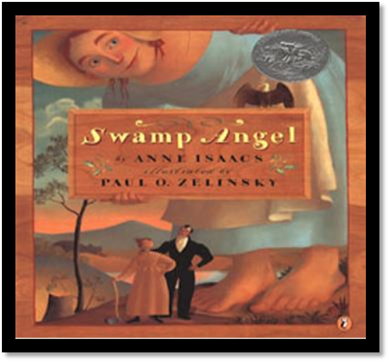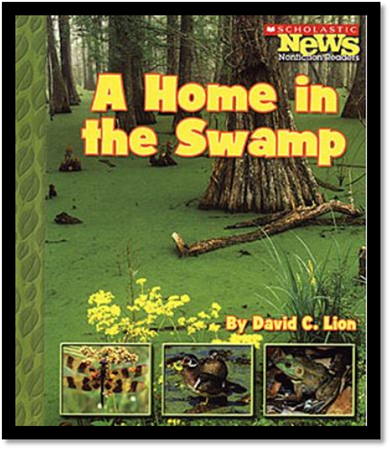Fairy Tales: Comparing Different Literary
Texts
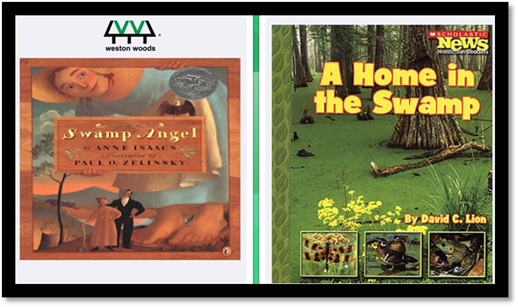
Figure 1 BookFlix
Unit Overview
This unit focuses on Fairy Tales, Compare and
Contrast, and Pronouns. You will be able to
accomplish the following objectives by the end of this unit:
1.
I can use spelling patterns and rules to help me spell new
words. L.3.2.F
2.
I can ask and answer questions to show that I understand the
stories that I am reading. RL.3.1
3.
I can find the answers to specific questions within the stories
that I read. RL.3.1
4.
I can remember and retell different kinds of stories from many
cultures. RL.3.2
5.
I can compare and contrast stories written about the same or
similar characters. RL.3.9
6.
I can write for short time frames or over a longer period of
time, depending on my purpose, audience, and topic. W.3.10
7.
I can explain how pronouns work in different sentences. L.3.1.A
8.
I can make sure that all my pronouns and the nouns they refer to
are correct in the sentences I say and write. L.3.1.F
Spelling List
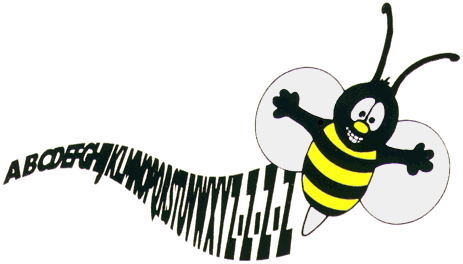
|
swimming |
having |
started |
|
swam |
doing |
joked |
|
getting |
ended |
received |
|
coming |
happened |
smiled |
|
came |
happening |
smiling |
Let's Practice
Click on Spelling Training to practice your spelling words. Add
each of your spelling words to the list. Then, complete one of the activities
below the list.
Vocabulary List
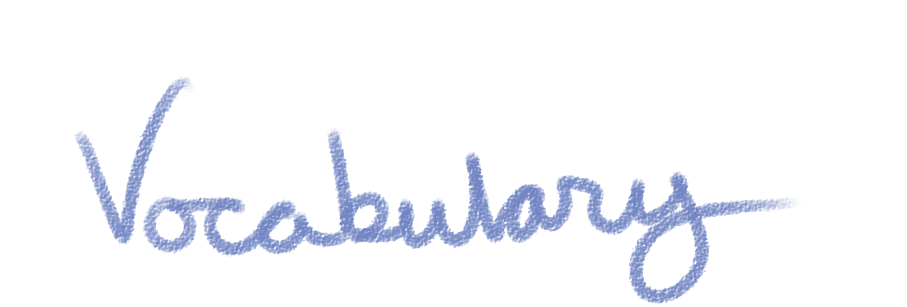
|
bog |
A small
swamp |
|
mired |
Stuck in the mud |
|
Covered wagon |
A large
wagon with a canvas cover that settlers traveled in across the country |
|
Root
cellar |
An underground room used
to store food |
|
settler |
A
person who traveled across the country in the 1800s to make a home in a new
area |
|
molasses |
A dark, sweet, sticky
syrup |
|
commenced |
began |
|
lasso |
A rope with a loop at
the end used to catch a cow or horse |
Above is your list of vocabulary words with their definitions.
Be sure to study and practice these words daily before you begin
your reading lessons.
Let's
Practice
Below is a Quizlet activity on your vocabulary
words for the unit. You should practice
the Flashcard and Learn activities each day during the week of this unit.
Fairy Tales
A fairy
tale is make-believe story that includes some magic. It often begins with
the words "Once upon a time..." and ends with "...lived
happily ever after."
Fairy tales are stories with good and evil
characters; the good characters usually win.

In the last unit, we learned what a fable is
and the parts of this type of story.
So, how would a fairy tale compare to a
fable?
The majority of these stories began as folktales. A folktale is:
·
An oral story
·
Author is unknown
·
Found in all cultures
·
"timeless" and "placeless" stories
Look below at the chart to compare a "Fairy
Tale" and a "Fable."
|
Elements |
Fairy Tale "Once
upon a time…" |
Fable very
short stories |
|
Characters |
royalty animals |
animals act like people |
|
Setting |
castle forest |
generally
outside somewhere |
|
Problem |
good versus evil |
only one
problem using trickery |
|
Solution |
lived happy ever after |
ends with a moral
(lesson) |
Let's
Practice
IXL Skill Check – Go to the Unit Resource
tab on the left and click Determine the themes of myths, fables, and
folktales to complete the skill.
Compare and Contrast
Authors often compare
and contrast two things in their writing.
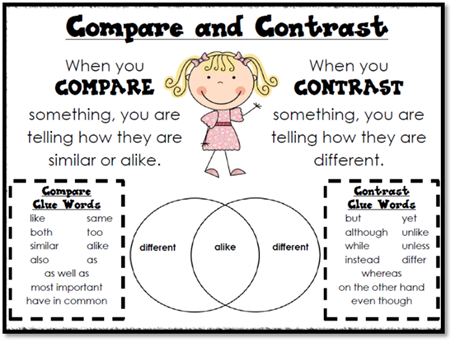
To compare is
to show how two things are alike. When authors compare, they often use signal
words such as like, same, both, also,
and too.
To contrast is
to show how two things are different. When authors contrast, they often use
signal words such as different, only, and while.
When you compare and contrast characters,
you think about how they are alike and how they are different. Look at each
character's actions and dialogue. These can tell
you how the characters feel and what they are like.
Let's
Practice
IXL Skill Check – Go to the Unit
Resource tab on the left and click Compare mythological illustrations to
complete the skill.
Reading Log & Journal
Writing journals can be
compelling to you as a student. It helps you respond to your
Read-Aloud and Oral Readings to gain further understanding. You must
write at least one journal per unit in this course based on one of your
readings. Click on the Unit Resource icon to
the left of your screen to download the Reading Log & Journal template. Also,
you have an option to create your journal book for this course.
Reading
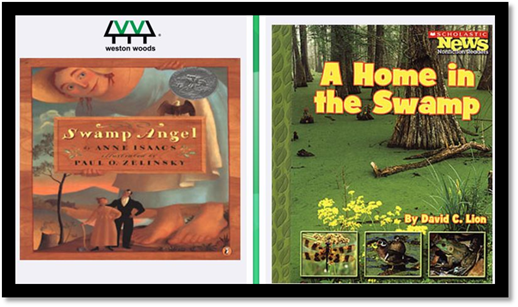
The above two stories will be used for your
Read Aloud and Oral Reading activities.
Read-Aloud
Your read-aloud is a fiction story called
"Swamp Angel."
This
is an original story told in the American frontier tradition of tall tales. The
Swamp Angel of the title is Angelica Longrider, who was born scarcely taller
than her mother and didn't build her first log cabin until she was a full two
years old. Swamp Angel tracks down and fights Thundering Tarnation, a huge bear
with a bottomless appetite, in the tallest tale of all. Swamp Angel's victory
comes only after she lassos the bear with a tornado and fights him all night in
her sleep.
As
you read/listen to the story, look for examples of exaggeration. Exaggeration
means describing something and making it more than it is. An example of exaggeration
would be: "I was walking, when suddenly this enormous dog came
along. It was as big as an elephant". The dog may have been big, but it
was certainly not as big as that. Another example of exaggeration would be: "I
caught a fish as big as my house."
Click the image below to begin your read-aloud
activity.
Did you hear the new vocabulary words? Did it help you to know what those words meant before you watched the video?
Did you find any examples of
exaggeration in this story?
Let's Practice
Your oral reading is a nonfiction text called
"A Home in the Swamp." This text introduces readers to the climate, habitats, animals, and
plants in a swamp.
This
text is nonfiction. Nonfiction tells about things that happen in real life. A
nonfiction book contains facts about a subject. The story "Swamp Angel"
is fiction. Fiction tells about things that are imaginary or make-believe.
Click the image below to begin your oral
reading activity.
Let's Practice
A pronoun is a
word that takes the place of a noun. I, you, he, she, we, they, me,
him, her, it, us, and them are examples of pronouns.

The video below will
provide examples of instances in a sentence where proper nouns can be replaced
with pronouns.
Let's
Practice
IXL Skill Check – Go to the Unit
Resource tab on the left and click Identify personal pronouns to
complete the skill.
Cursive Handwriting
A dinosaur bone looks like this:


As you can see, the word
bone begins with the cursive, lowercase letter "b."
Look at the animated
cursive, lowercase letter "b" below. Notice that it
begins with an undercurve stroke.
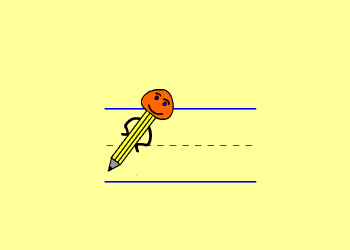
Let's practice writing the
undercurve stroke. Click on the Unit Resource icon to the left of your
screen to practice the Undercurve Stroke.
Now, you will practice the
cursive, lowercase "b" and join it to other
letters. Pay close attention to the
check stroke to undercurve joining. Click
on the Unit Resource icon to the left of your screen to practice the Lowercase "b".
Next, take a look at the
animated cursive, lowercase letter "i." Notice that it begins with an undercurve
stroke.
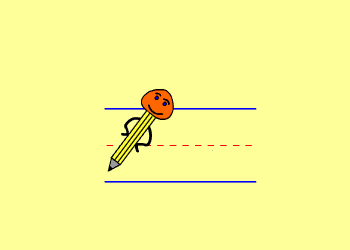
Next, let's practice the cursive letter "i." Pay close attention to the joining of "i"
and other letters. Notice that the
ending stroke of "i" begins the second letter. Click
on the Unit Resource icon to the left of your screen to practice the Cursive letter "i".
